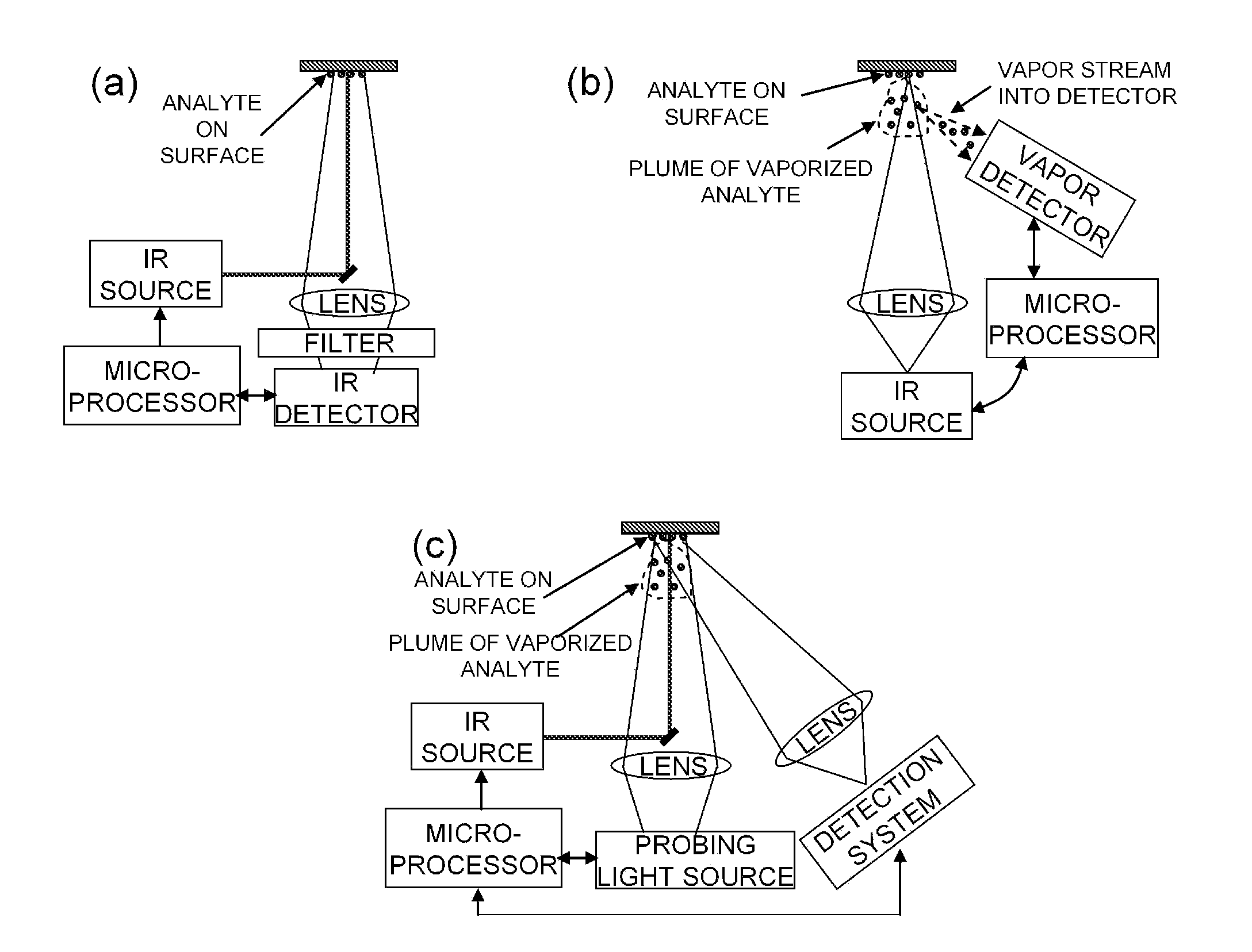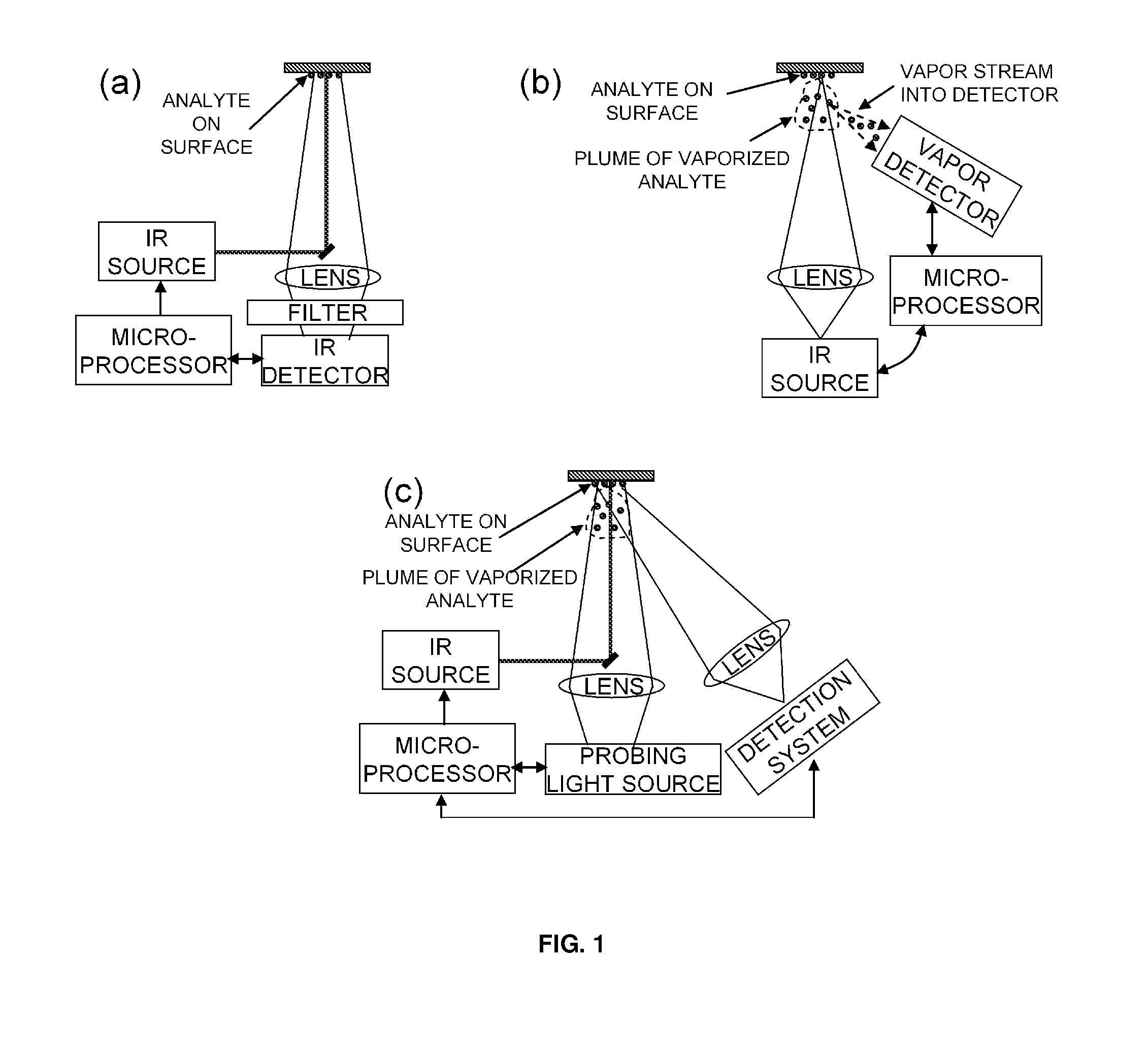Analyte detection with infrared light
an infrared light and analyte technology, applied in the field of chemical or biochemical detection, can solve the problems of significant glint problems, difficult to remove using normal physical rubbing or particle removal techniques, and dissociative desorption of related products, and achieve the effects of safe point, easy to remove, and efficient vaporization or probe particl
- Summary
- Abstract
- Description
- Claims
- Application Information
AI Technical Summary
Benefits of technology
Problems solved by technology
Method used
Image
Examples
example 1
[0074]A small sample of dimethylnitrobutane (DMNB) was positioned in a recessed stainless steel support inside a chamber under reduced pressure and positioned in line with a laser beam tuned to 6.45 microns. DMNB is a taggant that is added to formulation of explosives and has the same functional groups as some conventional explosives. It was selected for this experiment as a simulant or surrogate for an actual explosive but with very similar spectral properties. The laser used was a tunable free-electron laser. The operational characteristics of the laser were as follows: wavelength of 6.45 microns, 6 microsecond pulse train of 1 ps pulses at 2.8 GHz, energy density of 30-40 micro J / cm2.
[0075]Immediately after directing the laser beam onto the DMNB target a visible plume of material was ejected. Some of this material was collected on a neighboring substrate for characterization by FTIR. As shown in FIG. 5, the collected material had the same spectral signature as the starting DMNB t...
example 2
[0076]A small sample of 2,4-dinitrotoluene (24DNT) positioned on a test surface under ambient laboratory conditions was exposed to a laser beam tuned to 6.25 microns. 24DNT is a natural degradation product of and an impurity in TNT that is structurally very similar to TNT with one less nitro group. It was selected for this experiment as a close surrogate for TNT with very similar spectral properties which was desirable for the intended tests. The laser used was a tunable free-electron laser that allows the user to select a wide range of wavelengths.
[0077]The FEL tuned to 6.25 microns with 14 mJ pulses readily heated and partially vaporized the 24DNT slab (1 cm long) and 14 ms after a pulse from the laser a plume emitted is visible above the solid target. A sequence of still stroboscopic back-illuminated photos was collected in close sequence to generate a video recording the effects of the laser on the sample of 24DNT. One of the still photos is shown in FIG. 6. Some of the ejected ...
example 3
[0078]A small trace sample of RDX deposited separately on planar polyethylene and gold substrates was positioned (under ambient laboratory conditions) in line with a quantum cascade laser (QCL) beam with an output wavelength of 6.30 microns. The laser was focused to a spot size on the target of 1-2 mm2. To examine any light that was emitted from the RDX sample after exposure with the QCL, an infrared camera (Photon Block 2 from FLIR, sensitive to light in the 7-12 micron range) was positioned to examine any infrared light received back from the test substrate. RDX is a common explosive in land mines and other military ordnance.
[0079]FIG. 7 shows the thermal image of RDX deposited as a trace quantity on a polyethylene substrate, illumination with QCL at 6.3 microns (5 mW / mm2). Immediately after directing the laser beam onto the RDX target, infrared light was detected indicating that the sample was being heated. When using a polyethylene substrate, the RDX heating was visible even in ...
PUM
 Login to View More
Login to View More Abstract
Description
Claims
Application Information
 Login to View More
Login to View More - R&D
- Intellectual Property
- Life Sciences
- Materials
- Tech Scout
- Unparalleled Data Quality
- Higher Quality Content
- 60% Fewer Hallucinations
Browse by: Latest US Patents, China's latest patents, Technical Efficacy Thesaurus, Application Domain, Technology Topic, Popular Technical Reports.
© 2025 PatSnap. All rights reserved.Legal|Privacy policy|Modern Slavery Act Transparency Statement|Sitemap|About US| Contact US: help@patsnap.com



